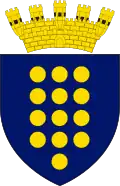Districts of Malta
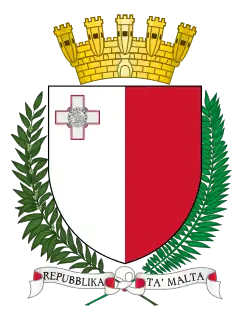 |
|---|
Malta is divided into districts. The four types of districts are regional councils, statistical districts, electoral districts, and policing districts.
Regional Councils
Malta is divided into six regions for local-government and administrative purposes. Three regions were originally created by the Local Councils Act of 1993, and were integrated into the constitution in 2001.[better source needed] Two of the regions were split into smaller ones by Act No. XVI of 2009, and Malta was divided into five regions.Act No. XIV of 2019 reorganized the subdivision, establishing six regions, and was implemented in November 2021
Each region has a Regional Council (Maltese: Kunsill Reġjonali), which consists of a Regional President, a Deputy President, an Executive Secretary and between 10 and 12 members.
Function
According to article 37B of the Local Governments' Act, the functions of Regional Councils include issuing calls for tenders for waste management services, conducting social impact evaluations, providing professional assistance across various sectors to local councils, coordinating with government entities and preparing annual Work Plans to address financial and human resource requirements.
Current regions
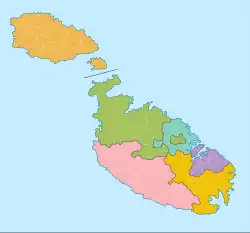
Gozo Region
Northern Region
Port Region
Southern Region
Western Region
| Coat of arms | Region | Seat | Largest city | Area (km²) |
Population (year) |
Density (per km²) |
Established |
|---|---|---|---|---|---|---|---|
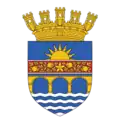
|
Eastern Region | San Ġwann (not part of the region) | Birkirkara | 20.3 km2 (7.8 sq mi) | 115,908 (2021)[1] | 5,700/km2 (15,000/sq mi) | 2021 |
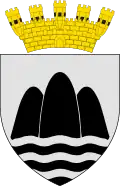 |
Gozo Region | Victoria | 67 km2 (26 sq mi) | 34,563 (2020)[2] | 520/km2 (1,300/sq mi) | 1993 | |
 |
Northern Region | St. Paul's Bay | 82.07 km2 (31.69 sq mi) | 118,588 (2020)[3] | 1,400/km2 (3,600/sq mi) | 2009 | |
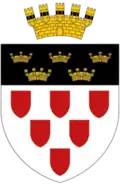
|
Port Region | Tarxien | Żabbar | 15.75 km2 (6.08 sq mi) | 69,880 (2020)[4] | 4,400/km2 (11,000/sq mi) | 2021 |
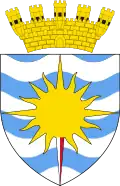 |
Southern Region | Qormi | 78.9 km2 (30.5 sq mi) | 106,593 (2021)[5] | 1,400/km2 (3,600/sq mi) | 2009 | |
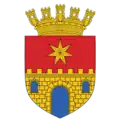
|
Western Region | Rabat | Żebbuġ | 83.2 km2 (32.1 sq mi) | 59,287 (2020)[6] | 710/km2 (1,800/sq mi) | 2021 |
Former regions (2009-2021)

Gozo Region
Northern Region
South Eastern Region
Southern Region
| Coat of arms | Region | Seat | Largest city | Area | Population (2014) | Population density | Established | Abolished |
|---|---|---|---|---|---|---|---|---|
| Central Region | San Ġwann | Birkirkara | 23.6 km2 (9.1 sq mi) | 111,994 | 4,700/km2 (12,000/sq mi) | 2009 | 2021 | |
| South Eastern Region | Valletta | Żabbar | 36.2 km2 (14.0 sq mi) | 99,301 | 2,700/km2 (7,000/sq mi) | 2009 | 2021 |
Former regions (1993–2009)
2: Malta Majjistral
3: Malta Xlokk
| Region | Largest city | Area | Population (2005) | Population density | Established | Abolished |
|---|---|---|---|---|---|---|
| Malta Majjistral | Birkirkara | 163 km2 (63 sq mi) | 227,117 | 1,393/km2 (3,610/sq mi) | 1993 | 2009 |
| Malta Xlokk | Żabbar | 64 km2 (25 sq mi) | 140,882 | 2,201/km2 (5,700/sq mi) | 1993 | 2009 |
Statistical districts and regions
Malta is divided into six districts for statistical purposes, as defined by the National Statistics Office and Eurostat. Each district comprises a number of local councils (LAU2). At the NUTS-3 level, these districts are grouped into two regions: Malta (comprising the first five districts) and Gozo and Comino (comprising the sixth).[7][8]
| Level (EU classification) | Meaning / Area type | Number of areas | Code | Name(s) |
|---|---|---|---|---|
| NUTS – Statistical Regions | ||||
| NUTS 1 | Country | 1 | MT0 | Malta |
| NUTS 2 | Country | 1 | MT00 | Malta |
| NUTS 3 | Islands | 2 | MT001 | Malta (island) |
| MT002 | Gozo, Comino | |||
| LAU – Local Administrative Units | ||||
| LAU 1 | Districts | 6 | — | Northern Harbour District |
| Southern Harbour District | ||||
| South Eastern District | ||||
| Western District | ||||
| Northern District | ||||
| Gozo and Comino District | ||||
| LAU 2 | Local councils | 68 | — | — |
Historically, the statistical districts were sometimes grouped into three larger statistical regions: Malta Majjistral (comprising the Northern Harbour, Western, and Northern Districts), Malta Xlokk (comprising the Southern Harbour and South Eastern Districts), and Gozo and Comino. This classification is no longer in official use.[9]
Southern Harbour District
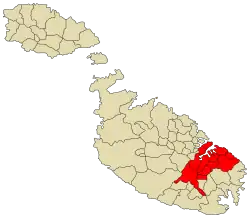
The Southern Harbour District forms part of Malta Xlokk. It contains 14 local councils including the all but western suburbs of the capital Valletta and the small cities Birgu, Cospicua, Senglea and Żabbar. Its largest locality is Żabbar; its smallest, Xgħajra.[10] The District's population is 80,170 (as of 31 December 2016) across its 26.1 km2. Thus it then ranked second-most populous and had the fifth-largest extent.
- Birgu (Vittoriosa) 2,451 population (at end 2016)
- Bormla (Cospicua) 5,147
- Fgura 11,714
- Floriana (Furjana) 1,966
- Senglea (Isla) 2,691
- Kalkara 3,006
- Luqa, include the hamlet of Ħal Farruġ 5,793
- Marsa (both parishes; the Parish of the Holy Trinity and the Parish of Maria Regina) 5,328
- Paola (Raħal Ġdid) (both parishes; the Parish of Christ the King and the Parish of Our Lady of Lourdes) 8,241
- Santa Luċija 2,929
- Tarxien 8,674
- Valletta (the four parishes; the Parish of Our Lady of Porto Salvo, the Parish of Our Lady of Mount Carmel, the Parish of St. Paul's Shipwreck and the Parish of St. Augustine) 5,656
- Xgħajra 1,673
- Żabbar, include the hamlet of St. Peter's[10] 14,901
Northern Harbour District
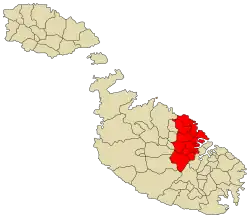
The Northern Harbour District forms part of the Central Region. It contains 13 local councils including the city of Qormi, with the largest locality being Birkirkara (pop. 22,314). The smallest one is Ta' Xbiex (pop. 1,657). The population of the District is 131,056 (as of 31 December 2016) across its 24.1 km2. It is the most populous and yet the smallest.
- Birkirkara (include the hamlets of Fleur-de-Lys (Parish of Our Lady of Mount Carmel) and Is-Swatar (Parish of St. George Preca) and the Parish of St. Helen, the Parish of St. Joseph the Worker and the Parish of St. Mary)
- Il-Gżira
- Il-Ħamrun (both parishes; the Parish of St. Gaetano and the Parish of the Immaculate Conception)
- L-Imsida
- Pembroke
- Tal-Pietà (include the hamlet of Guardamangia)
- Ħal Qormi (both parishes; the Parish of St. George and the Parish of St. Sebastian)
- San Ġiljan (include the hamlet of Paceville and the parish area of Balluta Bay)
- San Ġwann (include the hamlet of Il-Kappara)
- Santa Venera
- Tas-Sliema (the five parishes; the Parish of Stella Maris, the Parish of Sacro Cour, the Parish of St. Gregory, the Parish of Jesus of Nazareth and the Parish of Our Lady of Mount Carmel)
- Is-Swieqi (include the hamlet of Madliena)
- Ta' Xbiex
South Eastern District
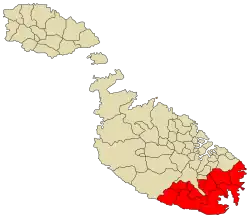
The South Eastern District forms part of Malta Xlokk. It contains 11 local councils including the city of Żejtun, with the largest locality being Marsaskala (pop. 12,281) while the smallest one is Ħal Safi (pop. 2,168). The population of the District is 68,044 (as of 31 December 2016) across its 54.3 km2. It is the fourth-largest district by population and area.
- Birżebbuġa
- Ħal Għaxaq
- Il-Gudja
- Ħal Kirkop
- Marsaskala (Wied il-Għajn)
- Marsaxlokk
- L-Imqabba
- Il-Qrendi
- Ħal Safi
- Iż-Żejtun
- Iż-Żurrieq (include the hamlet of Bubaqra)
Western District
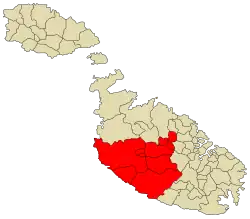
The Western District forms part of Malta Majjistral. It contains 10 local councils including the cities of Mdina, Siġġiewi and Żebbuġ, the most populous locality being Żebbuġ (pop. 11,759). The smallest one is Mdina (pop. 229). The population of the District is 59,817 (as of 31 December 2016) across its 72.5 km2. Thus it was the fifth-largest by population and has the second-largest extent.
- Ħ'Attard
- Ħal Balzan
- Ħad-Dingli
- L-Iklin
- Ħal Lija
- L-Imdina
- L-Imtarfa
- Ir-Rabat (include the hamlets of Baħrija and Tal-Virtù)
- Is-Siġġiewi
- Ħaż-Żebbuġ
Northern District
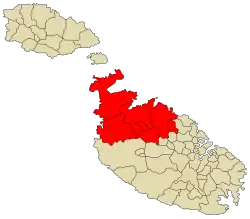
The Northern District forms part of the Northern Region. It contains 6 local councils but no cities, with the largest locality being St. Paul's Bay (pop. 29,843); its smallest is Għargħur (pop. 2,743). The population of the District is 69,467 (as of 31 December 2016) across its 73.6 km2. It is the third most populous and is the largest.
- Ħal Għargħur
- Il-Mellieħa (include the parish area of Manikata)
- L-Imġarr
- Il-Mosta
- In-Naxxar (include the hamlet of Baħar iċ-Ċagħaq)
- San Pawl il-Baħar (include the hamlets of Buġibba, Burmarrad and Qawra)
Gozo and Comino District
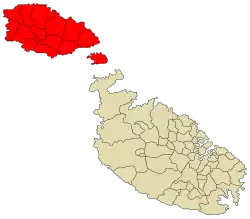
The Gozo and Comino District is also the Gozo Region. It contains 14 local councils including the city of Victoria (or Rabat). This is also the largest locality (pop. 6,211) while the smallest one is Għasri (pop. 418). The population of the District is 31,879 (as of 31 December 2016) across its 68.7 km2. It is the least populous district and the third biggest.
- Il-Fontana
- Għajnsielem (including Comino)
- L-Għarb
- L-Għasri
- Ta' Kerċem
- Il-Munxar
- In-Nadur
- Il-Qala
- San Lawrenz
- Ta' Sannat
- Ix-Xagħra
- Ix-Xewkija
- Ir-Rabat (Victoria)
- Iż-Żebbuġ
Electoral districts
There are currently 13 Electoral Divisions for the unicameral (single-assembly) parliament. Each consists of a number of localities (although there is no requirement that electoral boundaries follow the boundaries of localities).[11][12]

- Il-Birgu
- L-Isla
- Bormla
- Ħaż-Żabbar (including St. Peter's)
- Il-Kalkara
- Ix-Xgħajra
- Il-Fgura (Tal-Gallu area)
- Il-Fgura (Mater Boni Consigli and Tal-Liedna areas)
- Il-Gudja
- Paola
- Santa Luċija
- Ħal Tarxien
- Birżebbuġa
- Ħal Kirkop
- L-Imqabba
- Ħal Farruġ
- Il-Qrendi
- Ħal Safi
- Iż-Żurrieq (including Bubaqra)
- Ħad-Dingli
- L-Imġarr
- L-Imtarfa
- Ir-Rabat (including Il-Baħrija and Tal-Virtù)
- Ħaż-Żebbuġ
- Birkirkara (including Fleur-de-Lys and part of Swatar)
- L-Iklin
- Ħal Lija
- Ħal Balzan
- Ħal Għargħur
- L-Imsida (including part of Swatar)
- San Ġwann (including Il-Kappara)
- Is-Swieqi (including Tal-Ibraġ and Il-Madliena)
- Ta' Xbiex
- Il-Gżira
- Pembroke
- San Ġiljan (including Paceville)
- Tas-Sliema
- In-Naxxar (San Pawl tat-Tarġa, Birguma, Magħtab and Salina areas)
- Baħar iċ-Ċagħaq
- Il-Mellieħa (including Il-Manikata)
- In-Naxxar (Church area)
- San Pawl il-Baħar
This district consists of the islands of Gozo and Comino
- Ir-Rabat (Victoria)
- Il-Fontana
- Għajnsielem (including Comino)
- L-Għarb
- L-Għasri
- Ta' Kerċem (including Santa Luċija)
- Il-Munxar
- Ix-Xlendi
- In-Nadur
- Il-Qala
- San Lawrenz
- Ta' Sannat
- Ix-Xagħra
- Ix-Xewkija
- Iż-Żebbuġ (including Marsalforn)
Police districts
Following the 2022 amendments to the police district's boundaries and compositions, Malta has 2 police regions which fall under the responsibility of 2 distinct Assistant Commissioners. Each of these 2 regions consist of 6 police districts, amounting to a total of 12 districts. Each district is administered by its nominated Superintendent and has its own police headquarters.[13][14]
Region A
District 1
- Il-Belt Valletta, Archbishop Street
- Il-Furjana, St. Anne Street
- Pinto Police, Valletta Waterfront
- Headquarters in Valletta, the capital city of Malta
District 2
- Il-Ħamrun, St. Paul's Square
- Santa Venera, St. Joseph High Road
- Tal-Pietà and Gwardamanġa, St. Luke's Square
- Il-Marsa, Balbi Street
- Headquarters in Ħamrun
District 3
- Paola, Valletta Road
- Il-Fgura, Hompesch Road
- Santa Luċija, Tower Promenade
- Ħal Tarxien, Nelson Avenue
- Ħal Luqa and Ħal Farruġ St. Andrew Square
- Headquarters in Paola (Raħal Ġdid)
District 4
- Bormla St. Paul's Street
- Il-Birgu, Desain Street
- L-Isla, 4 September Street
- Il-Kalkara, Archbishop Gonzi Square
- Ix-Xgħajra, Church Street
- Ħaż-Żabbar and St. Peter's, Ċawsli Street
- Marsaskala, Żonqor Road
- Headquarters in Bormla (Città Cospicua)
District 5
- Iż-Żejtun, Mater Boni Consiglii Street
- Birżebbuġa, Pretty Bay
- Marsaxlokk, Fishermen's Strand
- Il-Gudja, Raymond Caruana Street
- Ħal Għaxaq, Labour Avenue
- L-Imqabba, Parish Street
- Ħal Kirkop, St. Benedict Street
- Ħal Safi, St. Paul's Street
- Iż-Żurrieq and Bubaqra, St. Catherine Street
- Wied iż-Żurrieq
- Il-Qrendi, Church Street
- Headquarters in Iż-Żejtun (Città Beland)
District 6
- Ħal Qormi Main Street
- Ħaż-Żebbuġ Parish Street
- Is-Siġġiewi St. Nicholas Square
- Għar Lapsi
- Headquarters in Qormi (Città Pinto)
Region B
District 7
- Tas-Sliema, Rudolph Street
- Il-Gżira, Belvedere Street
- L-Imsida and Ta' Xbiex, Rue d'Argens
- Headquarters in Tas-Sliema
District 8
- San Ġiljan, Paceville, and Pembroke, St. George's Road, Spinola Bay
- Is-Swieqi and Il-Madliena, Keffa Street
- San Ġwann and Il-Kappara, Naxxar Road
- Headquarters in San Giljan
District 9
- Birkirkara, Fleur-de-Lys and Is-Swatar, Main Street
- Ħal Balzan, Ħal Lija and L-Iklin, Bertu Fenech Square (Balzan)
- Ħ'Attard, Main Street
- Ta' Qali, Pitkalija
- In-Naxxar and Baħar iċ-Ċagħaq, Żenqa Street
- Ħal Għargħur, St. Albert Street
- Headquarters in Birkirkara, the second largest locality in Malta
District 10
- Il-Mosta, Constitution Street
- L-Imġarr, Fisher Street
- Ir-Rabat, Il-Baħrija and Tal-Virtù, St. Rita Street
- Ħad-Dingli, Main Street
- L-Imdina, St. Publius Square
- L-Imtarfa, Maltese Regiments Street
- Headquarters in Il-Mosta, the third largest locality in Malta
District 11
- San Pawl il-Baħar, Burmarrad and Ix-Xemxija, St. Paul's Street
- Il-Qawra and Buġibba, Tourist Street
- Il-Mellieħa, Parish Square
- Iċ-Ċirkewwa, Ċirkewwa Terminal
- L-Għadira
- Headquarters in San Pawl il-Bahar, the largest locality in Malta
District 12
- Kemmuna, Congrave Street
- Il-Fontana, Ta' Mulejja Street
- Għajnsielem, Simirat Street
- L-Għarb, Church Street
- L-Għasri, Saviour Square
- Ta' Kerċem and Santa Luċija, Sarġ Street
- Marsalforn, Marina Street
- Il-Port tal-Imġarr, Coast Road
- Il-Munxar, Munxar Road
- In-Nadur, Saints Peter and Paul Square
- Il-Qala, St. Joseph Street
- Ramla Bay
- San Lawrenz, St. Lawrence Square
- Ta' Sannat, Sannat Road
- Ta' Pinu
- Ix-Xagħra, 8 September Avenue
- Ix-Xewkija, Independence Street
- Ix-Xlendi, St. Andrew Street
- Iż-Żebbuġ, Church Street
- Ir-Rabat, Għawdex (Victoria), Republic Street
- Gozo Fire Brigade
- Headquarters in Ir-Rabat, Għawdex (Victoria), the capital city of Gozo
References
- ^ "Social Impact Assessment - Reġjun Lvant". Reġjun Lvant. Retrieved 2024-04-13.
- ^ "Regional Cultural Strategy Booklet Gozo" (PDF). Arts Council Malta.
- ^ "Regional Cultural Strategy Booklet North" (PDF). Arts Council Malta.
- ^ "Regional Cultural Strategy Booklet Port" (PDF). Arts Council Malta.
- ^ "Social Impact Assestment Southern Regional Council" (PDF). Reġjun Nofsinhar. Retrieved 2024-04-16.
- ^ "Regional Cultural Strategy Booklet West" (PDF). Arts Council Malta.
- ^ "Statistical Concepts, Definitions and Classifications" (PDF). National Statistics Office (Malta). Retrieved 14 August 2025.
- ^ "Statistical regions in Malta". Eurostat. Retrieved 14 August 2025.
- ^ "Population Statistics" (PDF). National Statistics Office (Malta). 22 June 2016. Retrieved 14 August 2025.
- ^ a b Saviour Formosa; Sandra Scicluna; Jacqueline Azzopardi, eds. (January 2013). Realities of Crime, Society and Landuse in the Mediterranean: JANUS I (PDF). Msida: Department of Criminology, University of Malta. pp. 59–60. doi:10.13140/2.1.1230.4322. ISBN 978-99957-834-0-2. Archived from the original on 15 March 2017.
- ^ Gauci, Salv. (23 April 2012). "Constitution of Malta. Article 61 – Electoral Divisions" (PDF). The Malta Government Gazette. No. 18904. Retrieved 26 August 2014.
- ^ "Electoral Divisions". Electoral Commission Malta. Retrieved 30 January 2019.
- ^ Micallef, Mario (28 February 2022). "Police Force draws up its new districts to better address the needs of today and the future". TVM News. Retrieved 3 March 2022.
- ^ Ellul, James Aaron (17 February 2022). "Jinbiddlu d-distretti li tagħhom huma responsabbli l-għases tal-Pulizija". NET News. Retrieved 3 March 2022.
